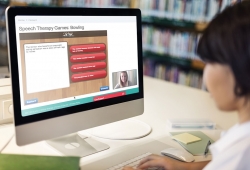Minneapolis, MN, February 06, 2018 –(PR.com)– Participating in an intensive early childhood education program from preschool to third grade increases college graduation rates at age 35, according to a new study by University of Minnesota researchers.
The study, published in JAMA Pediatrics, tracked the progress of more than 1,500 children from low-income neighborhoods in Chicago, from the time they entered preschool in 1983 and 1984 in the Child-Parent Centers (CPC) until roughly 30 years later. The children are part of the Chicago Longitudinal Study, one of the longest-running follow-ups of early childhood intervention.
“Children from low-income families are less likely to attend college than their higher-income peers,” said lead author Arthur J. Reynolds, a professor at the University of Minnesota Institute of Child Development and director of the Chicago Longitudinal Study. “A strong system of educational and family supports in a child’s first decade is an innovative way to improve educational outcomes leading to greater health and economic well-being. The CPC program provides this, and it can be scaled.”
Chicago Mayor Rahm Emanuel notes "Every child deserves a strong foundation for a successful future, and this report provides more concrete, compelling evidence that investments in early childhood education pay dividends for decades. Chicago is expanding access to early childhood education so every child, regardless of their zip code or parents' income, can have the building blocks for a lifetime of success.”
First Study of Public-School Program to Mid-life
The JAMA Pediatrics study is the first of a large-scale public program to assess impacts on mid-life attainment and the contributions of continuing services in elementary school. Educational attainment is the leading social determinant of health. The study’s co-authors include Suh-Ruu Ou and Judy A. Temple of the University of Minnesota’s Human Capital Research Collaborative. Reynolds and Temple are co-directors of this center.
For the study, which was funded by the National Institutes of Health, the researchers followed the progress of 989 graduates of the Chicago Public School District’s CPC program, which provided intensive instruction in reading and math from preschool through third grade as part of a school reform model.
The program provides small classes, intensive learning experiences, menu-based parent involvement, and professional development. The children’s parents received job skills training, parenting skills training, educational classes and social services. They also volunteered in their children’s classrooms, assisted with field trips, and attended parenting support groups.
Increasing Educational Attainment from CPC
The authors compared the educational outcomes of those children to the outcomes of 550 children from low-income families who attended other early childhood intervention programs in the Chicago area. Information on the children from administrative records, schools and families, from birth through 35 years of age. College records were obtained from the National Student Clearinghouse. More than 90 percent of the original sample had available data on educational attainment. The study was rigorously designed and had a larger sample than previous studies. Potential bias due to leaving the study and other factors were taken into account, which provide strong confidence about the positive impacts of the program.
On average, CPC graduates – whether they participated in preschool only, or through second or third grade – completed more years of education than those who participated in other programs.
For children who received an intervention in preschool, those in the CPC group were more likely to achieve an associate’s degree or higher (15.7 percent vs. 10.7 percent), a bachelor’s degree (11.0 percent vs. 7.8 percent), or a master’s degree (4.2 percent vs. 1.5 percent). These differences translate to a 47 percent increase in an earned associate’s degree and a 41 percent increase in an earned bachelor’s degree.
CPC graduates through second or third grade showed even greater gains: a 48 percent increase in associate’s degree or higher (18.5 percent vs. 12.5 percent) and a 74 percent increase for bachelor’s degree or higher (14.3 percent vs 8.2 percent). Completion of any postsecondary credential (degree or occupational certificate) also was higher.
“This study shows that a well run early childhood intervention program can have benefits well into adult life,” said James Griffin, Ph.D., Deputy Chief of the Child Development Branch at the Eunice Kennedy Shriver National Institute of Child Health and Human Development at the National Institutes of Health.
Consequences and Sources of Benefits
According to the authors, successful early childhood programs not only may lead to higher adult educational achievement, but also to improved health. The authors note that adults with less education are more likely to adopt unhealthy habits like smoking and to experience high blood pressure, obesity, and mental health problems than those who complete more schooling.
What are the key program elements? Reynolds indicates the significance of the following: (1) child to staff ratios no higher than 17 to 2 (25 to 2 in K-3), (2) intensive focus on readiness skills within a developmental whole child philosophy, (3) provision of family services, (4) frequent monitoring and feedback, (5) teachers have BAs and/or are compensated at comparable levels of K-12 teachers, and (6) a well-developed organizational support system (schools or community wide).
In previous studies, the researchers showed that CPC program participants have attained higher incomes, and experienced lower rates of serious crime, incarceration, and depression than participants of other programs. CPC has also shown a return on investment: cost-benefit analyses have shown economic returns of 7 to 10 dollars per dollar invested.
The CPC program expanded beyond Chicago beginning in 2012. The program is now also in parts of Minnesota, Illinois, and Wisconsin.
Funding for the study is from the National Institute of Child Health and Human Development and the Bill & Melinda Gates Foundation. To read the full open-access paper titled, “A Multicomponent, Preschool to Third Grade Preventive Intervention and Educational Attainment at 35 Years of Age,” visit the JAMA Pediatrics website at jamanetwork.com/journals/jamapediatrics.
Human Capital Research Collaborative, an interdisciplinary research center at the University of Minnesota offers a multitude of resources for CPC P-3 implementation, including monitoring tools, manuals, and extensive resources on the website, CPCP3.org.
Contact Information:
Human Capital Research Collaborative
Judy Temple
651-230-7957
Contact via Email
hcrc.umn.edu
Read the full story here: https://www.pr.com/press-release/743864
Press Release Distributed by PR.com




